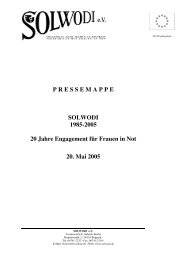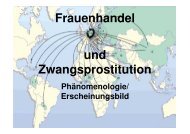Sponsored Vocational Training: Dream of Escape or Reality - Solwodi
Sponsored Vocational Training: Dream of Escape or Reality - Solwodi
Sponsored Vocational Training: Dream of Escape or Reality - Solwodi
Create successful ePaper yourself
Turn your PDF publications into a flip-book with our unique Google optimized e-Paper software.
Efficacy <strong>of</strong> SOLWODI’s <strong>Vocational</strong> <strong>Training</strong> Scheme 6<br />
education and training gender disparities exist with participation <strong>of</strong> girls below 30 percent<br />
(Ngware, 2002: 27). A large prop<strong>or</strong>tion (52 percent) <strong>of</strong> trainees drops out due to financial<br />
problems (Manda, 2006: 52). Don<strong>or</strong> agencies and NGOs such as SOLWODI are involved in the<br />
provision <strong>of</strong> VT in the post-compuls<strong>or</strong>y education years. Acc<strong>or</strong>ding to an ILO/IPEC study in<br />
2006, 40 percent <strong>of</strong> trainees were funded by international agencies, <strong>or</strong>ganisations, church and<br />
guardians, unlike 2 percent who were able to finance their VT themselves and the remaining 58<br />
percent who were spons<strong>or</strong>ed by their parents (Mutie, 2006: 28).<br />
International agencies such as UNESCO and ILO refer to VT as Technical, Industrial,<br />
<strong>Vocational</strong> and Entrepreneurship <strong>Training</strong> (TIVET): training that immediately relates to w<strong>or</strong>k.<br />
Kenya’s TIVET exists <strong>of</strong> five training levels: artisan, craftsman, technician, technologist and<br />
master <strong>of</strong> technology. It is accessible from primary as well as from secondary school. Due to<br />
the fact that SOLWODI <strong>of</strong>fers training solely at the artisan level, in the prevailing paper the<br />
moniker VT instead <strong>of</strong> TIVET will be exclusively applied. SOLWODI’s trainees are not only<br />
enrolled in public training institutions, Youth Polytechnics (YP) and Christian Industrial<br />
<strong>Training</strong> Centres (CITC), but also directly in apprenticeship training within the Jua Kali, i.e.<br />
inf<strong>or</strong>mal sect<strong>or</strong> where the pr<strong>of</strong>ound focus is on practical skills. None <strong>of</strong> SOLWODI’s trainees<br />
have been instructed and graduated beyond the artisan level. YP trainees are by large primary<br />
education graduates, although some trainees are drawn from secondary school. There is a wide<br />
spectrum <strong>of</strong> different training institutions available in Kenya: Some institutes place emphasis<br />
heavily on vocational skills training and less on business skills, some are m<strong>or</strong>e intertwined with<br />
practical w<strong>or</strong>k; others focus by large on the<strong>or</strong>y (King, 1996: 174). The Government <strong>of</strong> Kenya<br />
stipulated that technical and vocational training ‘play[s] a crucial role in developing artisans,<br />
managers and entrepreneurs f<strong>or</strong> the inf<strong>or</strong>mal sect<strong>or</strong> in both rural and urban areas’ (GoK, 1986:<br />
57).<br />
D. NGOs in general and in Kenya, in particular<br />
Traditionally, NGOs are described as voluntary, non-pr<strong>of</strong>it <strong>or</strong>ganisations that operate<br />
independently from the commercial and governmental sect<strong>or</strong>. NGOs primarily focus on two<br />
goals: service providing and development promoting. NGOs attempt to effectively service<br />
human needs, to consult members <strong>of</strong> society, to protect and to represent the interest <strong>of</strong> po<strong>or</strong> and<br />
voiceless. The W<strong>or</strong>ld Bank defines NGOs as ‘groups and institutions that are entirely






